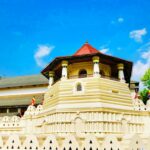When it comes to planning a wedding, there are so many things to consider – from the ceremony and reception venues down to details like flowers and cake.
But have you ever thought about incorporating some Cambodian wedding traditions into your special day?
Cambodian weddings are steeped in centuries of cultural history, with beautiful ceremonies that offer something unique for couples looking for an unforgettable experience.
From pre-wedding rituals to post-wedding customs and superstitions, this blog will explore all the different Cambodian wedding traditions available.
Including dress codes, music choices, and insight into how best to bring a little bit of Cambodia’s culture into your big day.
So let’s dive into the wonderful world of Cambodian wedding traditions.
Cambodian Wedding Traditions
1. Music and Dance Traditions
Music and dance are an integral part of any wedding celebration. Cambodian weddings, in particular, feature various traditional songs and dances that have been passed down through generations.
Popular Cambodian Wedding Songs and Dances:
Popular Cambodian wedding songs include “Kamry Phnom” (The Mountain of Gold), “Cha Cha Chai” (Let’s Dance) and “Srok Srae” (A Beautiful Place).
These upbeat tunes are often accompanied by lively dances such as the Robam Apsara, which is a graceful form of Khmer classical dance; the Robam Preah Reach Trop or Royal Dance; and the Romvong, which is a circle dance with hand clapping.
Live Music Performance at Weddings:
Live music performances are also popular at Cambodian weddings.
Traditional instruments used for these performances include drums, gongs, xylophones, and flutes. The musicians usually play along to popular folk songs or traditional melodies while guests sing along or join in on the dancing.
In addition to drums, gongs, and xylophones mentioned above, other traditional instruments used in Cambodia include stringed instruments like the tro sau khlang (two-stringed fiddle) and wind instruments like bamboo flutes called khloy sralai or chapei dang veng (long-necked lute).
All these musical elements come together to create an unforgettable atmosphere for any special occasion.
Cambodian music and dance traditions are an integral part of the wedding celebration, with traditional songs and dances being performed to create a lively atmosphere.
Pre-Wedding Traditions
In Cambodia, pre-wedding traditions are an important part of the wedding ceremony. These rituals and customs are meant to bring good luck and blessings to the couple as they embark on their journey together.
2. Engagement Ceremony
The engagement ceremony is a formal event where both families meet and agree upon the marriage terms.
This is usually done in front of family members, friends, or religious leaders who will bless the union with prayers and wishes for a happy life together.
During this time, gifts such as jewelry or money may be exchanged between both parties as a sign of commitment.
3. Bride Price Negotiation/Dowry
Bride price negotiation is an essential part of Cambodian weddings that involves negotiations between both families regarding how much money should be paid by the groom’s family to the bride’s family for her hand in marriage.
This amount can vary depending on factors such as social status or wealth but typically ranges from $1,000-$10,000 USD depending on region and custom.
Dowry preparation involves gathering items such as furniture, clothing, jewelry, or other goods that will become part of the bride’s dowry when she moves into her new home with her husband after marriage.
Traditionally these items were given by close relatives, but nowadays, it has become more common for couples to purchase them themselves before their wedding day.
Pre-Wedding Traditions are a vital part of Cambodian weddings, where families come together to celebrate the union of two people in love.
Wedding Day Traditions
On the wedding day itself, there are several traditional ceremonies that take place to bless the couple and ensure their future happiness.
4. The Wedding Day
The first of these is a procession to the bride’s home. This typically involves friends and family members of both sides gathering at the groom’s house before heading off together toward the bride’s house.
Along the way, they may sing songs or perform other rituals, such as lighting candles or incense sticks.
Once they arrive at her home, they will be welcomed by her family, who will then lead them into a special room where further blessings can be exchanged between both families.
5. Hair-Cutting
The second ceremony is known as a hair-cutting ceremony which symbolizes the transition from single life to married life for both parties involved.
The groom’s mother will cut off some of his hair while he holds onto an egg for good luck, and then she will do likewise with the bride’s hair.
This ritual means that no matter what happens in life, their bond remains strong like an unbreakable eggshell.
6. Food and Drink
At a Cambodian wedding, traditional foods are usually served to honor the occasion. Food is an integral part of these weddings.
Popular dishes include fish amok, khmer red curry, beef loc lac, rice cakes filled with pork or beef, fish cooked in coconut milk, vegetable curries, noodle soups, and grilled meats served with dipping sauces.
Also, there will generally be fruits such as mangoes and jackfruit, desserts like sticky rice pudding, or sweet pancakes filled with bananas or coconuts.
Beverages include tea infused with herbs or fruit juices mixed with soda water, coconut milk, sugarcane juice, and fermented beverages such as palm wine or spirits.
7. Gifting
Finally, an exchange of gifts and blessings between both families serves as another way for them to express their love and support for one another on this important day.
Gifts usually include items such as jewelry, money, or clothing, but it could also involve more symbolic offerings such as fruits or flowers, which represent fertility and abundance, respectively.
Both sets of parents may also offer words of wisdom during this time so that each couple can start on their journey together with all the necessary guidance.
Wedding day traditions in Cambodian culture are steeped in symbolism and honor, from the procession to the bride’s home to exchange gifts and blessings.
As the couple embarks on their new life together, post-wedding traditions such as receptions, blessings by elders, and returning of the bride to her family home further signify their union.
Post-Wedding Traditions
After the wedding, there are still some post-wedding traditions that must be observed for the marriage to be considered complete.
These include reception celebrations, the return of the bride to her family home, and a blessing of the newlyweds by elders.
8. Reception Celebrations
After tying the knot, it’s time to celebrate. This usually involves hosting a grand party with friends and family members where everyone can come together and enjoy delicious food and drinks while congratulating the newly married couple.
It is also customary for guests to bring gifts or money as tokens of their congratulations.
9. Return of The Bride To Her Family Home
In many cultures around the world, after getting married, it is traditional for the bride to return back home with her husband at least once before they start living together permanently.
This symbolizes respect towards both families involved in this union and an opportunity for them all to get acquainted with each other better.
A very important part of any wedding ceremony is when older relatives or community leaders bless the newlywed couple on their special day.
This could involve anything from offering wisdom about how best to manage a successful marriage to giving them religious blessings so that they may have a long life filled with love and joy together.
Post-wedding traditions are an integral part of Cambodian weddings, with celebrations, blessings, and superstitions playing a key role in the festivities.
Other Customs and Superstitions
10. Customs and Superstitions
Cambodian weddings are full of traditions and superstitions that have been passed down for generations. From the engagement ceremony to the reception, many customs and beliefs must be taken into account when planning a wedding.
Traditional Dress and Jewelry Worn by the Bride and Groom: The bride typically wears a traditional Cambodian outfit called a “sampot” which is made from silk or cotton fabric with intricate embroidery designs.
She also wears jewelry such as gold earrings, necklaces, bracelets, rings, anklets, headpieces, and other accessories. The groom usually wears an outfit similar to what he would wear on any other special occasion but with more elaborate details such as embroidered patterns or colors.
He may also wear jewelry such as gold chains or watches, depending on his preference.
Superstitious Beliefs Related to Weddings:
There are several superstitious beliefs related to Cambodian weddings that must be taken into consideration when planning one’s nuptials.
For example, it is believed that if two people who are not married touch each other during the ceremony, then they will never get married themselves.
It is also considered bad luck if someone sneezes while getting dressed up for their wedding day.
Additionally, some believe that if you cut your hair before your wedding day, you will experience marital problems later on in life, so it’s best avoided.
Finally, it is said that couples should avoid taking photos of themselves together until after they have exchanged vows; otherwise, their marriage might end prematurely.
These customs and superstitions play an important role in Cambodian weddings, so understanding them can help ensure everything goes smoothly on one’s big day.
Conclusion
Cambodian wedding traditions are a beautiful way to celebrate the union of two people.
From pre-wedding customs, such as offering food and drink to the ancestors, to ceremony traditions, like the tying of strings around the couple’s wrists, there is no shortage of ways for couples to honor their culture during their special day.
The dress and attire, music and dance, and food and drink all come together in a unique blend that makes Cambodian weddings truly one-of-a-kind.
Whether you’re looking for traditional or modern ideas on how to make your wedding stand out from others or just intrigued by Cambodian customs, exploring some Cambodian wedding traditions can be an excellent place to start.




